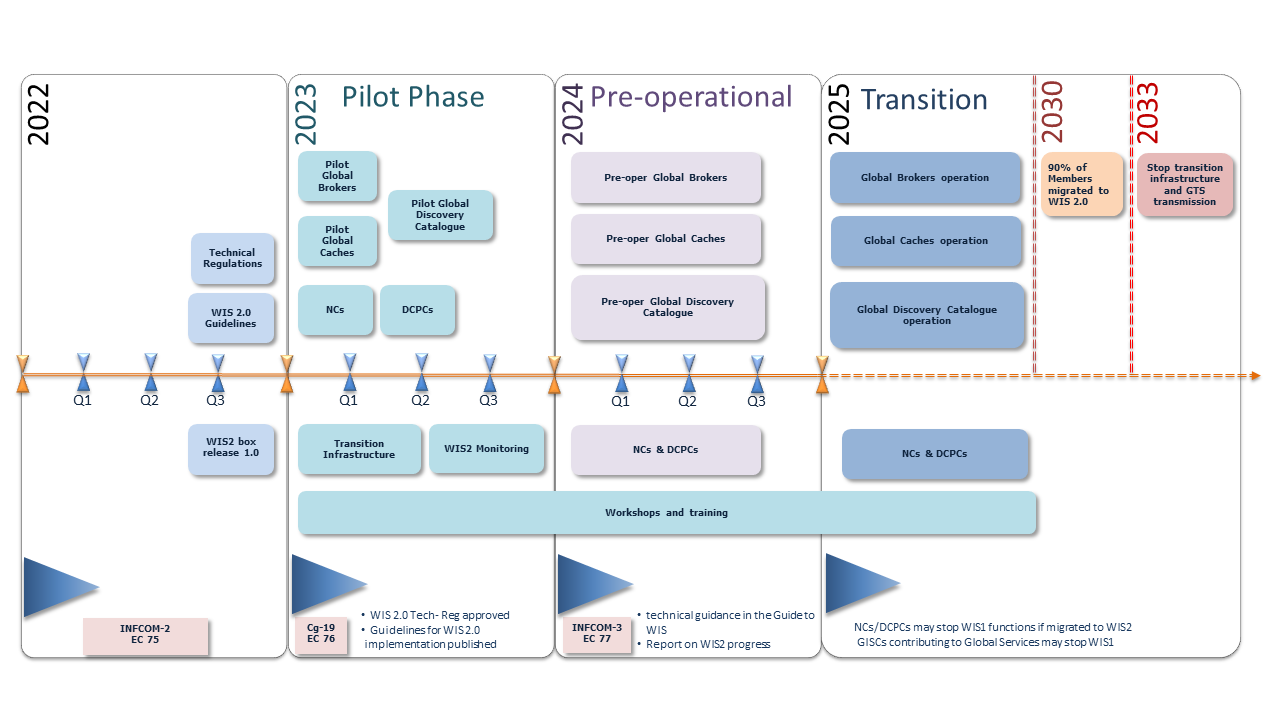Draft Guidance on Transition from GTS to WIS 2.0
Recommendation of the provision for The transition from WIS 1.0 and Global Telecommunication System (GTS) to WIS 2.0, including capacity development was approved at INFCOM-3 which was held from 15 to 19 April 2024, to be adopted at EC-78.
- Download the Transition Guide here.
WIS 2.0 implementation plan
The WMO Information System 2.0 (WIS 2.0) will be implemented according to the schedule provided in Figure 1. A one-year pilot phase will start at the end of 2022, with several countries collaborating in building the WIS 2.0 infrastructure. Each Country will have a different role in the WIS 2.0 framework and will implement a specific component.

Figure 1 WIS 2.0 Implementation Timeline
Guidance on transition from GTS to WIS 2.0
According to the WIS 2.0 implementation plan (see figure 1), the Global Telecommunication System (GTS) will be decommissioned by 2030, and National Meteorological and Hydrological Services NMHSs will use the WIS 2.0 platform for data exchange. During the transition period, there will be a mix of centers operating WIS 2.0 and WIS/GTS. Some of them will be running both data-sharing frameworks simultaneously, with the difficulties associated with maintaining two operational systems for the same purpose. Therefore, a transition plan will be developed during the pilot phase, taking into account the time necessary for Members to migrate to the new systems and reducing, at the minimum, the time of parallel operation of both systems for a Member.
Transition principles
The following principles are appropriate for the transition:
Principle 1: Each NMHS will be able to make the migration during the agreed period 2025-2030:
- Considering the fact that not all centers have the same skills and facilities, and the operational aspects of WIS and the risks involved in a big-bang approach, the WIS node implementation would not be fully implemented at the same time.
Principle 2: No « GTS » data loss during the transition:
- During the pilot phase, and in coordination with the regional associations and GISCs, WIS 2.0 infrastructure will be established in order to avoid data loss during the transition. The aim of this infrastructure is to ensure that data sent on the GTS can be received by a site having migrated on WIS2, and data, previously sent on the GTS, sent on WIS2 can be received by a site still on the GTS.
Principle 3: Each Center will decide when decommissioning the WIS1 and GTS:
- Decommissioning WIS1 services, as well as GTS ones, will be the decision of each NC/DCPC/GISC when they will consider that their and their user’s migration is completed.
- After migration to WIS2, It is not required to run an MSS to receive or send data from Centers not having made the transition. The Center will decide when and if they want to stop their Message Switching System MSS. They can also stop the data dissemination to GTS.
Principle 4: New data (eg. GBON, Climate, Hydrology, Cryosphere) will be exchanged solely on WIS2:
- WIS 2.0 is designed to to enable the WMO Unified Data Policy, and to support the WMO Global Basic Observing Network. The new data will be available on WIS2. A center not having made the migration to WIS2 will not receive the new data. This data will not have a GTS headers TTAAii and will not be exchanged over the GTS
(Last update: 19 April 2024)
